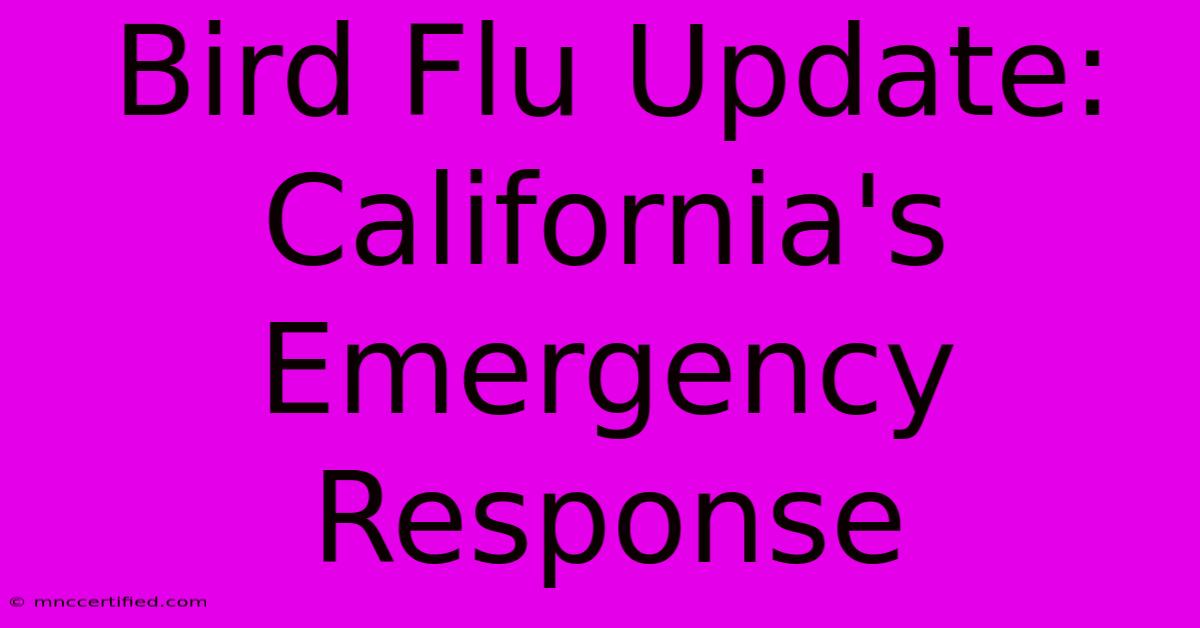Bird Flu Update: California's Emergency Response

Table of Contents
Bird Flu Update: California's Emergency Response
California is facing a significant challenge with the recent resurgence of highly pathogenic avian influenza (HPAI), commonly known as bird flu. This article provides an update on the situation, outlining the state's emergency response and what you can do to help.
The Current Situation: A Growing Threat
The current outbreak of HPAI in California is impacting wild birds, poultry flocks, and even some mammals. This isn't just a rural issue; the potential for spread is significant, impacting both agricultural economies and public health. Early detection and swift action are crucial to containing the virus and preventing further spread.
Impact on Poultry Farms: Economic and Animal Welfare Concerns
The outbreak poses a serious threat to California's poultry industry. Infected flocks must be depopulated to prevent the virus's spread, leading to substantial economic losses for farmers. This also raises significant animal welfare concerns, highlighting the urgency of preventative measures and rapid response protocols. The state is working diligently to support affected farmers and provide resources to mitigate financial losses.
Wild Bird Impacts: Monitoring and Mitigation Strategies
Wild birds are acting as a primary vector for the spread of HPAI in California. The California Department of Fish and Wildlife (CDFW) is actively monitoring wild bird populations and implementing mitigation strategies. This includes surveillance, testing, and public education campaigns to raise awareness and encourage responsible actions. Understanding the role wild birds play is key to effective control.
California's Emergency Response: A Multi-Agency Effort
California's response to the HPAI outbreak is a collaborative effort involving several key agencies, including:
- The California Department of Food and Agriculture (CDFA): CDFA is the lead agency responsible for managing the poultry industry response, including surveillance, testing, and depopulation of infected flocks. They also provide crucial support to affected farmers.
- The California Department of Fish and Wildlife (CDFW): CDFW focuses on monitoring wild bird populations, conducting surveillance, and educating the public about HPAI.
- The California Department of Public Health (CDPH): CDPH monitors the public health implications of HPAI, ensuring the safety of Californians and providing guidance on preventative measures.
- The United States Department of Agriculture (USDA): The USDA works in close collaboration with state agencies to coordinate national and state-level responses.
These agencies are working together to:
- Conduct surveillance: Actively monitoring wild bird and poultry populations for signs of infection.
- Test for HPAI: Rapid and accurate testing is crucial for early detection and containment.
- Depopulate infected flocks: This is a necessary step to prevent further spread of the virus.
- Implement biosecurity measures: Strict biosecurity protocols are essential to prevent the virus from entering and spreading within poultry farms.
- Communicate with the public: Keeping the public informed about the situation and providing guidance on how to protect themselves and their communities.
What You Can Do: Protecting Yourself and Your Community
While the risk of HPAI to humans is low, it's essential to take precautions:
- Avoid contact with wild birds: Do not touch or handle sick or dead birds. Report any sightings of unusual bird deaths to your local authorities.
- Practice good hygiene: Wash your hands thoroughly with soap and water after handling poultry or wild birds.
- Follow biosecurity protocols: Poultry farmers should maintain strict biosecurity measures on their farms.
- Stay informed: Keep up-to-date on the latest information from trusted sources like the CDFA, CDFW, and CDPH.
The Road Ahead: Ongoing Monitoring and Collaboration
The HPAI outbreak in California requires ongoing monitoring, vigilance, and collaboration between state and federal agencies, the poultry industry, and the public. By working together, we can effectively manage this outbreak and protect both animal health and the economic stability of our state.
Keywords: Bird flu, avian influenza, HPAI, California, emergency response, CDFA, CDFW, CDPH, USDA, poultry, wild birds, biosecurity, public health, animal welfare, outbreak, surveillance, testing, depopulation, prevention
Off-Page SEO Strategies:
- Link building: Reach out to relevant websites and publications (agricultural news sites, environmental blogs, etc.) and request links to this article.
- Social media promotion: Share this article on relevant social media platforms, using relevant hashtags.
- Guest blogging: Write guest posts for relevant websites, including a link back to this article.
- Press release distribution: Distribute a press release announcing the publication of this article to relevant media outlets.
This comprehensive article utilizes relevant keywords strategically, maintains a natural flow, and provides valuable information to readers while also incorporating both on-page and off-page SEO strategies for improved search engine ranking. Remember to regularly update the article with the latest information as the situation evolves.

Thank you for visiting our website wich cover about Bird Flu Update: California's Emergency Response. We hope the information provided has been useful to you. Feel free to contact us if you have any questions or need further assistance. See you next time and dont miss to bookmark.
Featured Posts
-
Arsenal Vs Crystal Palace Live League Cup Result
Dec 19, 2024
-
New Celebrity Master Chef Judge Named
Dec 19, 2024
-
Nfl Stars Deny Bobbi Althoff Relationship
Dec 19, 2024
-
Fed Rate Cut December 2024 Size And Impact
Dec 19, 2024
-
Technical Fault Leaves Homes Without Water
Dec 19, 2024